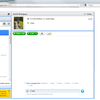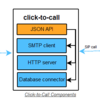 Google's Chrome team stated in their recent WebRTC roadmap that the main components of WebRTC are now stable and they will be releasing it to the 200M+ Chrome users later this year. However, they want developers to get a sneak preview of what will be in the first WebRTC release. I should mention that two days ago I discussed how Skype and Microsoft were working on a HTML5 web-version of Skype. I felt that HTML5 would be inadequate and any Skype web app would likely also use WebRTC. So the news from the Google Chrome team is very timely and very interesting. I said last year Google was looking to build Skype in the browser and it looks like the end of 2012 will bring those efforts to fruition.
Google's Chrome team stated in their recent WebRTC roadmap that the main components of WebRTC are now stable and they will be releasing it to the 200M+ Chrome users later this year. However, they want developers to get a sneak preview of what will be in the first WebRTC release. I should mention that two days ago I discussed how Skype and Microsoft were working on a HTML5 web-version of Skype. I felt that HTML5 would be inadequate and any Skype web app would likely also use WebRTC. So the news from the Google Chrome team is very timely and very interesting. I said last year Google was looking to build Skype in the browser and it looks like the end of 2012 will bring those efforts to fruition.What's in the initial WebRTC release includes the following:
JSEP
JSEP (Javascript Session Establishment Protocol) is an API for signaling that allows for much more powerful apps and flexibility in choice of signaling protocols. To abstract the complexity, we provide and maintain a Javascript lib that makes browser to browser calls a few lines of Javascript.
Topologies
Our implementation will support multiple independent PeerConnections, each capable of sending and receiving multiple independent media sources.
ICE / STUN / TURN
ICE and STUN are standardized methods for establishing a peer-to-peer connection on the Internet, even if the two end points are behind private network addresses (NAT). Chrome’s current stack deviates from the official current standards. We are working to fix this.
We will also support TURN servers to allow connections through tougher firewalls, where relaying and encapsulation are needed. Exactly what type of TURN will be supported is TBD.
DTLS-SRTP
Encryption will be mandatory for all usage of WebRTC in Chrome. For our first stable release, we will implement DTLS-SRTP.
VP8, iSAC, iLBC, G.711
The video codec support by Chrome will be VP8. We've made several major improvements inside and around VP8 to ensure it can deliver a great real time experience. On the audio side, we will initially support iSAC, iLBC, G.711, and DTMF, with iSAC being the default. It is a royalty free wideband codec optimized for speech, open sourced at webrtc.org.
I should mention WebRTC will also work on Firefox browsers with Mozilla doing some early demos of it in action and Microsoft is expected to support it in Internet Explorer. As for the future, Google announced some of their plans. The next release will include a Data API, screen sharing, PeerConnection proxying and recording - though the MediaRecorder specification hasn't been completed yet. The PeerConnection proxying is interesting since it will allow users to bypass restrictions that restrictive countries put in place. Think of WebRTC as Tor but for VoIP and video and more feature-rich collaboration. Exciting times ahead!













